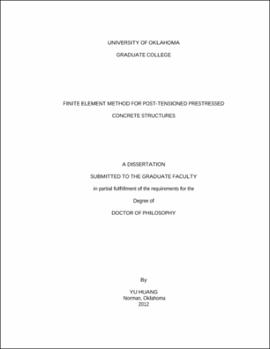| dc.contributor.advisor | Kang, Thomas | |
| dc.creator | Huang, Yu | |
| dc.date.accessioned | 2019-04-27T21:36:31Z | |
| dc.date.available | 2019-04-27T21:36:31Z | |
| dc.date.issued | 2012 | |
| dc.identifier | 99335171302042 | |
| dc.identifier.uri | https://hdl.handle.net/11244/319136 | |
| dc.description.abstract | This research discusses and investigates possible approaches for modeling post-tensioned (PT) prestressed concrete structures via the finite element method (FEM). The challenge of modeling PT prestressed concrete structures lies in the treatment of the interface between the concrete and prestressing tendons. The generic modeling techniques that are discussed were based on general purpose finite element packages. Two strategies for modeling the interface are presented in detail. For the first method, a series of linear spring elements was introduced to approximate the sliding behavior of prestressing tendons at the interface. For the second method, the interface was modeled directly through contact formulation. Additionally, the corresponding material constitutive relations, element preference and solution algorithm are discussed in depth. The generic modeling schemes were validated against experiments, and proved to be robust and reliable for modeling PT structures. However, slightly overestimated tendon stresses were observed at the ultimate state of structures in many numerical simulations. A preliminary scientific analysis yields the conclusion that the phenomenon is likely caused by the frictionless assumption which neglects the frictional-induced prestress loss in the modeling. | |
| dc.description.abstract | Besides the issue of overestimated prestressing tendon stress, it is difficult to apply the generic modeling schemes to simulate large-scale PT structures such as a PT frame system. The involvement of the solid element combined with the explicit dynamic algorithm becomes a large barrier to modeling large-scale structures due to the computational anxiety. The later part of the research zeros in on the development of an innovative nonlinear finite element formulation which incorporates contact techniques and engineering elements to considerably reduce the need of computational power. A nonlinear prototype program was developed to model PT prestressed concrete frames in two-dimensional space accordingly. The stress solution of prestressing tendons was also improved by considering frictional effects in the formulation. The proposed formulation was validated against analytic solutions and experimental data via several numerical studies. The prototype program was also demonstrated to be versatile and robust for analyzing PT prestressed concrete frames. Although the currently implemented material constitutive relations and beam element in the prototype program limit its applications, advanced material models and beam elements could be implemented into the current formulation with trivial works in the future. | |
| dc.description.abstract | In addition to the study of modeling techniques, three practical engineering problems were investigated through the proposed FEM. The investigated problems include: (1) punching shear failure of two-way PT prestressed concrete slabs; (2) prestress increment in the prestressing tendon at the service stage of structural members; and (3) influence of the PT systems (i.e., bonded vs. unbonded) on structural performance of typical PT members. A series of numerical simulations based on general purpose finite element packages were conducted according to the documented experiments. The extensive analyses of the numerical and experimental data lead to the following conclusions: (1) the eccentric shear stress model proposed in ACI 318 predicts reasonable moment-shear interaction mechanisms for PT interior, edge, and, corner slab-column connections; (2) in the case of PT edge and corner connections, the punching shear provisions in ACI 318 are overly conservative in some cases, more research is suggested to quantify the prestressing effect on punching shear capacity and to relieve some of the provisions; and (3) the bonding condition of prestressing tendons has no effect on flexural strength of PT one-way slabs and beams, or the moment-shear interaction in two-way PT interior slab-column connections. | |
| dc.format.extent | 345 pages | |
| dc.format.medium | application.pdf | |
| dc.language | en_US | |
| dc.relation.requires | Adobe Acrobat Reader | |
| dc.subject | Post-tensioned prestressed concrete | |
| dc.subject | Concrete construction | |
| dc.subject | Finite element method | |
| dc.title | FINITE ELEMENT METHOD FOR POST-TENSIONED PRESTRESSED CONCRETE STRUCTURES | |
| dc.type | text | |
| dc.type | document | |
| dc.thesis.degree | Ph.D. | |
| ou.group | College of Engineering::Department of Engineering | |
